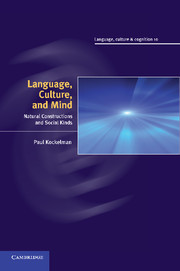Book contents
- Frontmatter
- Contents
- List of illustrations
- Acknowledgements
- 1 Language, culture, mind: emblems of the status human
- 2 Inalienable possessions: what hearts, mothers, and shadows have in common
- 3 Interclausal relations: how to enclose a mind by disclosing a sign
- 4 Myths about time and theories of mind: why the moon married the sun
- 5 Other minds and possible worlds: when psychological depth is dialogical breadth
- 6 Interjections: why the centre of emotion is at the edge of language
- 7 Conclusion: natural constructions and social kinds
- Appendix A Transcription conventions
- Appendix B The Marriage between the Sun and the Moon
- References
- Index
4 - Myths about time and theories of mind: why the moon married the sun
Published online by Cambridge University Press: 04 May 2010
- Frontmatter
- Contents
- List of illustrations
- Acknowledgements
- 1 Language, culture, mind: emblems of the status human
- 2 Inalienable possessions: what hearts, mothers, and shadows have in common
- 3 Interclausal relations: how to enclose a mind by disclosing a sign
- 4 Myths about time and theories of mind: why the moon married the sun
- 5 Other minds and possible worlds: when psychological depth is dialogical breadth
- 6 Interjections: why the centre of emotion is at the edge of language
- 7 Conclusion: natural constructions and social kinds
- Appendix A Transcription conventions
- Appendix B The Marriage between the Sun and the Moon
- References
- Index
Summary
Introduction
This Q'eqchi'-Mayan myth describes the difficulties suffered by B'alamq'e (the sun) in his attempt to elope with Po (the moon), as they try to outwit and outrun her father Tzuultaq'a (or ‘mountain-valley’, the telluridian god of the Q'eqchi'). In broad terms, the text may be thought of as a cosmogony of the Q'eqchi' world – narrating events that take place in time, as undertaken by actors who are time, to explain the nature of time. But more prosaically, it provides an ontogeny for, and taxonomy of, all poisonous creatures. It discusses the origins of the heavens, and the populating of the earth. It describes how women put signs of their daily experience into the cloth they are weaving. It explains why men lead women. And it accounts for the origins of coughing.
A key goal of this chapter is to use this myth about time as an entry into local understandings of mind. In particular, by carefully analysing the linguistic and cultural mediation of time, we will gain access to intentional horizons implicit in genres of speaking: the conditions for, and consequences of, differential overlaps in who knows what about others' beliefs, feelings, and intentions. As will be seen, the master trope of this myth is the difference between appearance and essence, deceitfulness and honesty, or character and performer, as elaborated in the local idiom of containers and contents.
- Type
- Chapter
- Information
- Language, Culture, and MindNatural Constructions and Social Kinds, pp. 85 - 119Publisher: Cambridge University PressPrint publication year: 2010



